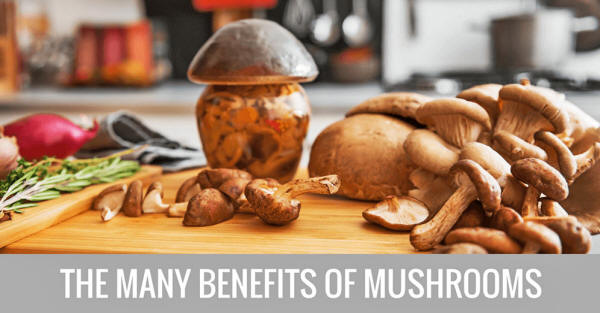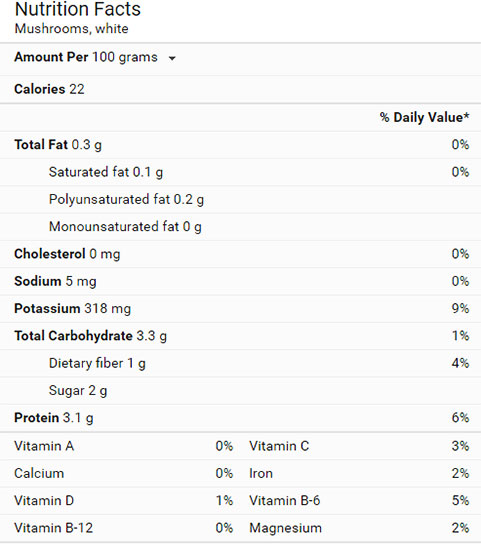|

by Joey Bruno
April 25,
2017
from
ThriveCuisine Website
|
Joey
Bruno
Also known as the "Hairy Vegan Animal", cooking healthy,
delicious, plant-based meals has been Joey's true
passion since he went vegan in 2015.
He's
committed to making the internet a place of education
and knowledge rather than misinformation and clickbait.
He
currently lives in Delaware with his wife. |

The Basics of Mushrooms
What are
Mushrooms Anyway?
Most people are
aware that mushrooms are a type of
fungus, however, many people
are unaware of how complex and important mushrooms are for our
health and ecosystem.
Some characteristics of these fungi, without getting too
biologically technical, are highlighted below:
-
Fungi "eat" by absorbing dissolved molecules from
their environment (they don't photosynthesize).
-
Fungus is defined as a group of which include
yeasts,
molds, and
of course mushrooms.
-
They act as the main decomposers within an
ecosystem.
-
Most of the time, you don't notice fungi unless it
is "fruiting" (via mushrooms or molds) which is
their method of spreading spores.
In simple
terms, when you eat a mushroom, you're eating the "fruiting
body" of a larger organism.
The primary
purpose of the fruiting body is spreading spores through the air
to continue the growth of the overall organism.
Nutritional Value of Mushrooms
For the purpose
of nutrition, we should consider the most commonly available
mushroom in supermarkets, aptly named the "common mushroom".
These mushrooms
actually come in two separate colors - white in brown. Baby
Bella and Crimini mushrooms are the two types of common
mushrooms you've likely seen.
In addition to
the two most common names listed above, they can also be
called:

Nutrition Facts for the
Common
Mushroom
Much like plant
foods, mushrooms are low in calories and high in micronutrients.
While the above
chart shows a low percentage of the vitamins that mushroom
contains, it's important to note that 22 calories of cooked
mushrooms would be quite small in terms of portion size and
daily caloric needs.
That being
said, if you ate 100 calories of mushrooms, you'd be getting
around 5X the micronutrient percentages listed on the nutrition
facts above.
Mushrooms also
contain 0.14 grams of protein per
calorie which is actually greater than chicken which has
0.11 grams per calorie.
If eaten in
enough quantity, mushrooms can actually be a decent lean protein
source.
Studies Done on Mushrooms
Mushrooms and the Immune System
SIgA, short for
Secretory immunoglobulin A, is the immune system's first
line of defense for our body's mucosal surfaces.
Mucosal
surfaces are membranes made up of
epithelial cells. These cells facilitate absorption and
secretion in glands and intestines.
Mucosal surfaces line certain
tracts and glands in the body including:
-
The
Mouth
-
Gastrointestinal Tract
-
Respiratory Tract
-
Genitals
-
Breast Glands
These sites are
our body's primary ways of absorbing things from the outside
world such as bacteria, viruses and toxins.
Increasing our
body's secretions of SIgA increases our initial defenses thus
increasing our overall immune function.
Researchers
who conducted
the study "Dietary
intake of Agaricus Bisporus white button Mushroom accelerates
salivary Immunoglobulin A secretion in Healthy Volunteers" decided to put white button mushrooms to the test
to see if consuming them lead to increased levels of SIgA in the
saliva.
Being that the mouth is one of our
body's primary mucosal surfaces, having increased levels of SIgA
in our saliva increases our ability to fight off bacteria,
viruses and toxins from the outside world.
Twenty-four
healthy volunteers were asked to eat their normal diet, but the
volunteers in the test group were told to consume 100g of
blanched white button mushrooms per day for a week. Researchers
then tested the participants' saliva.
They found those in the test group had over a
50% increase of SIgA for 2 weeks,
which then returned back to baseline by week 3.
Researchers
therefore concluded that white button mushrooms do indeed have
potential health benefits for improving immune function on the
body's mucosal surfaces.
The dietary
intake of A. bisporus WBM significantly accelerates sIgA
secretion, thereby indicating its potential health benefits
for improving mucosal immunity.
It's also been
shown by
the study "Anti-inflammatory
activity of Methanolic extracts from edible Mushrooms in LPS
activated RAW 264.7 Macrophages"
(in vitro/test tube) that mushrooms
won't increase inflammation.
Rather, they have an anti-inflammatory effect.
This is good
news for those who may have an overactive immune system from
conditions such as allergies.
Some edible
mushrooms species have a potential anti-inflammatory
capacity in vitro, suggesting that they could be
regarded as a potential source of natural anti-inflammatory
agents.
See the
video and link below for an
expanded view of this topic.
Mushrooms and Our Immune System
by Dr.
Michael Greger
Mushrooms and Our Arteries
We know that
CVD or cardiovascular disease is the
number one killer in Western and developed countries.
"The
etiology (development) of CVD involves, in part, a complex
process of development and deposition of cholesterol ladened
fatty streaks within aortic blood vessels and appears
associated with oxidative stress and inflammation"
source
To simply
summarize, the first level of protection against cardiovascular
disease would to avoid high levels of bad (LDL) cholesterol in
the blood.
The next level
of prevention would be avoiding inflammation so that fatty
arterial streaks are not developed.
In periods of
inflammation, certain processes such as monocyte
adhesion can occur:
Monocytes
are white blood cells that can
potentially get absorbed into the cardiovascular system
hence the term monocyte adhesion.
These researchers conducted an experiment in vitro (test
tube/culture dish) to see if specialty and common mushrooms
can inhibit certain cellular processes that are associated with
inflammation in the arteries (such as binding of
monocytes), which is associated
with CVD.
Here's what
happened:
Human
aortic endothelial cells were soaked in a control
medium or a medium containing extracts of several different
mushrooms:
-
Agaricus bisporus
(white button and crimini)
-
Lentinula edodes
(shiitake)
-
Pleurotus
ostreatus (oyster)
-
Grifola frondosa (maitake)
After
being incubated overnight, researchers found that the cells
that were incubated with the mushrooms
bound significantly less monocytes
in pro-inflammatory conditions which again is an
associative factor of CVD.
Researchers
quoted:
These
data provide evidence that dietary mushrooms can inhibit
cellular processes such as adhesion molecule expression
and ultimate binding of monocytes to the endothelium
under pro-inflammatory conditions, which are associated
with CVD.
As a
result, these findings support the notion that dietary
mushrooms can be protective against CVD.
For those among
us who are budget
conscious - the common white
mushroom actually performed the best, so there's no
reason to go out seeking any kind of expensive and exotic fungi.
See the
video and link below for an
expanded view of this topic.
Mushrooms and Our Arteries
by
Dr. Michael Greger
Mushrooms and Breast Cancer
Research has
shown that an enzyme called
aromatase
plays a big role in the development of breast cancer.
This enzyme is
responsible for synthesizing estrogen which can be utilized by
tumors to proliferate (study -
Anti-Aromatase Activity of Phytochemicals
in White Button Mushrooms).
Because
anti-aromatase phytochemicals are
also present in plant foods such as white button mushrooms,
researchers decided to investigate whether or not white button
mushroom extract in a petri dish (in vitro) could
prevent the proliferation of breast
cancer cells (White
Button Mushroom Phytochemicals Inhibit Aromatase Activity and
Breast Cancer Cell Proliferation).
Researchers
confirmed that this was indeed the case.
They concluded
that:
Diets high
in mushrooms may modulate the aromatase activity and
function in chemoprevention in postmenopausal women by
reducing the in situ production of estrogen.
In addition,
based on the first above study we referenced in which researchers actually
tested mushroom extracts in mice - researchers concluded:
...consumption of 100 g of mushrooms per day would be
sufficient to suppress breast tumor growth in women
This means that
you don't need to eat tons and tons of mushrooms to see the
benefits!
See the
video and link below for an
expanded view of this topic.
Mushrooms and
Breast Cancer
by
Dr. Michael Greger
Potential Downsides of Mushrooms
Special thanks to Dr. Joel Fuhrman for
pointing out this research in his
article on mushrooms. We
highly recommend that you check it out to learn more!
While it's clear
that mushrooms have a ton of benefits, it is also important to
examine what some potential drawbacks may be. The primary drawback
of mushrooms seem to be from consuming them raw, much like
Kale which we touched on in our other article.
In
this study (Cancer
Induction in Mice by Feeding of the Uncooked Cultivated Mushroom of
Commerce Agaricm bisporus), scientists took the uncooked common mushroom (Agaricus
bisporus) as mentioned above and fed it to mice in a feeding trial
to test the very hypothesis of uncooked mushrooms being
carcinogenic.
Researchers were
unfortunately able to induce the mice with cancerous tumors in
several different areas throughout their body.
However, cooking
the mushrooms does reduce
their agaritine content substantially, but doesn't degrade it
completely. While the evidence on mushrooms and cancer is far from
conclusive, there are still huge health benefits from eating a
moderate amount of cooked mushrooms per day.
Given that researchers recommend that you would only need
approximately 100 g per day to reap the benefits, we recommend
eating mushrooms regularly, but not in overzealous amounts.
More isn't always
better.
And always cook them!
Delicious Mushroom Recipes
Mushroom and Potato
Stew
Stew can be a
comforting meal on a cold winter day.
Because we
don't recommend eating meat products on Thrive Cuisine,
mushrooms can do the same job that meat would in a stew
providing an earthy, nutty, and umami flavor as well as a
different texture than vegetables.
This stew is
simple, delicious, and super nutritious so we suggest you give
it a try!
Portabello Mushrooms
Sliders
Because of
their high protein content that we discussed before, mushrooms
can actually make great burgers! In this video, the Edgy Veg
shows you how to create some super simple sliders out of
mushrooms and some other great vegan toppings.
Enjoy!
One Pot Creamy
Mushrooms Pasta
When it comes
to simplicity and deliciousness,
Cooking
with Plants never disappoints. This easy to create pasta
dish will please the entire family without breaking a sweet in
the kitchen.
Highly
recommended for those busy week days.
Conclusions
While they are
often overlooked as health promoting foods (compared to fruits and
veggies anyway), there is definitely a place for mushroom
consumption in a diet focused on well-being and disease prevention.
Based on what we
learned throughout all the studies, regular white button mushrooms
should be consumed regularly (but no need to exceed 100 g per day.)
Just be sure to
cook the mushrooms before you eat them!
Raw mushrooms don't taste particularly good anyway!
|



